Continuous Monitoring of Pigs in Fattening Using a Multi-Sensor System: Behavior Patterns
Abstract
Simple Summary
Abstract
1. Introduction
2. Materials and Methods
2.1. Animals
2.2. Temperature Measurements
2.3. Data Analysis
3. Results and Discussion
3.1. Animal Temperature vs. Environment Temperature and Day-Night Cycles
3.2. Animal Temperature
3.3. Electronic Feeding Stations
3.4. Behavior Patterns
4. Conclusions
Author Contributions
Funding
Acknowledgments
Conflicts of Interest
References
- Loughmiller, J.A.; Spire, M.F.; Dritz, S.S.; Fenwick, B.W.; Hosni, M.H.; Hogge, S.B. Relationship between mean body surface temperature measured by use of infrared thermography and ambient temperature in clinically normal pigs and pigs inoculated with actinobacillus pleuropneumoniae. Am. J. Vet. Res. 2001, 62, 676–681. [Google Scholar] [CrossRef]
- Andersen, H.M.-L.; Jørgensen, E.; Dybkjær, L.; Jørgensen, B. The ear skin temperature as an indicator of the thermal comfort of pigs. Appl. Anim. Behav. Sci. 2008, 113, 43–56. [Google Scholar] [CrossRef]
- Labussière, E.; Dubois, S.; van Milgen, J.; Noblet, J. Partitioning of heat production in growing pigs as a tool to improve the determination of efficiency of energy utilization. Front. Physiol. 2013, 4, 146. [Google Scholar] [CrossRef] [PubMed]
- Meunier-Salaün, M.-C.; Guerin, C.; Billon, Y.; Sellier, P.; Noblet, J.; Gilbert, H. Divergent selection for residual feed intake in group-housed growing pigs: Characteristics of physical and behavioural activity according to line and sex. Animal 2014, 8, 1898–1906. [Google Scholar] [CrossRef] [PubMed]
- Soerensen, D.D.; Pedersen, L.J. Infrared skin temperature measurements for monitoring health in pigs: A review. Acta Vet. Scand. Suppl. 2015, 57, 5. [Google Scholar] [CrossRef] [PubMed]
- Case, L.; Wood, B.; Miller, S. Investigation of body surface temperature measured with infrared imaging and its correlation with feed efficiency in the turkey (meleagris gallopavo). J. Therm. Biol. 2012, 37, 397–401. [Google Scholar] [CrossRef]
- Soerensen, D.D.; Clausen, S.; Mercer, J.B.; Pedersen, L.J. Determining the emissivity of pig skin for accurate infrared thermography. Comput. Electron. Agric. 2014, 109, 52–58. [Google Scholar] [CrossRef]
- DiGiacomo, K.; Marett, L.; Wales, W.; Hayes, B.; Dunshea, F.; Leury, B. Thermoregulatory differences in lactating dairy cattle classed as efficient or inefficient based on residual feed intake. Anim. Prod. Sci. 2014, 54, 1877–1881. [Google Scholar] [CrossRef]
- Lao, F.; Brown-Brandl, T.; Stinn, J.; Liu, K.; Teng, G.; Xin, H. Automatic recognition of lactating sow behaviors through depth image processing. Comput. Electron. Agric. 2016, 125, 56–62. [Google Scholar] [CrossRef]
- Nasirahmadi, A.; Edwards, S.A.; Sturm, B. Implementation of machine vision for detecting behaviour of cattle and pigs. Livest. Sci. 2017, 202, 25–38. [Google Scholar] [CrossRef]
- Cornou, C.; Lundbye-Christensen, S. Classification of sows’ activity types from acceleration patterns using univariate and multivariate models. Comput. Electron. Agric. 2010, 72, 53–60. [Google Scholar] [CrossRef]
- Leliveld, L.M.; Düpjan, S.; Tuchscherer, A.; Puppe, B. Behavioural and physiological measures indicate subtle variations in the emotional valence of young pigs. Physiol. Behav. 2016, 157, 116–124. [Google Scholar] [CrossRef] [PubMed]
- Hoy, S.; Schamun, S.; Weirich, C. Investigations on feed intake and social behaviour of fattening pigs fed at an electronic feeding station. Appl. Anim. Behav. Sci. 2012, 139, 58–64. [Google Scholar] [CrossRef]
- Requejo, J.M.; Garrido-Izard, M.; Correa, E.C.; Villarroel, M.; Diezma, B. Pig ear skin temperature and feed efficiency: Using the phase space to estimate thermoregulatory effort. Biosyst. Eng. 2018, 174, 80–88. [Google Scholar] [CrossRef]
- Fernández, J.; Fàbrega, E.; Soler, J.; Tibau, J.; Ruiz, J.L.; Puigvert, X.; Manteca, X. Feeding strategy in group-housed growing pigs of four different breeds. Appl. Anim. Behav. Sci. 2011, 134, 109–120. [Google Scholar] [CrossRef]
- Baumung, R.; Lercher, G.; Willam, A.; Sölkner, J. Feed intake behaviour of different pig breeds during performance testing on station. Arch. Anim. Breed. 2006, 49, 77–88. [Google Scholar] [CrossRef]
- Fernández Capo, J. Descripción del Comportamiento Alimentario en Cuatro Razas Porcinas y Estudio de su Relación con la Productividad, el gen del Halotano y la Jerarquía Social; Universitat Autónoma de Barcelona: Barcelona, Spain, 2001. [Google Scholar]
- Stygar, A.; Dolecheck, K.; Kristensen, A. Analyses of body weight patterns in growing pigs: A new view on body weight in pigs for frequent monitoring. Animal 2018, 12, 295–302. [Google Scholar] [CrossRef]
- Nielsen, B.L.; Lawrence, A.B.; Whittemore, C.T. Effect of group size on feeding behaviour, social behaviour, and performance of growing pigs using single-space feeders. Livest. Prod. Sci. 1995, 44, 73–85. [Google Scholar] [CrossRef]
- Labroue, F.; Guéblez, R.; Sellier, P.; Meunier-Salaün, M. Feeding behaviour of group-housed large white and landrace pigs in french central test stations. Livest. Prod. Sci. 1994, 40, 303–312. [Google Scholar] [CrossRef]
- Rauw, W.; Soler, J.; Tibau, J.; Reixach, J.; Gomez Raya, L. Feeding time and feeding rate and its relationship with feed intake, feed efficiency, growth rate, and rate of fat deposition in growing duroc barrows. J. Anim. Sci. 2006, 84, 3404–3409. [Google Scholar] [CrossRef]
- Fàbrega, E.; Tibau, J.; Soler, J.; Fernández, J.; Font, J.; Carrión, D.; Diestre, A.; Manteca, X. Feeding patterns, growth performance and carcass traits in group-housed growing-finishing pigs: The effect of terminal sire line, halothane genotype and age. Anim. Sci. 2003, 77, 11–21. [Google Scholar] [CrossRef]
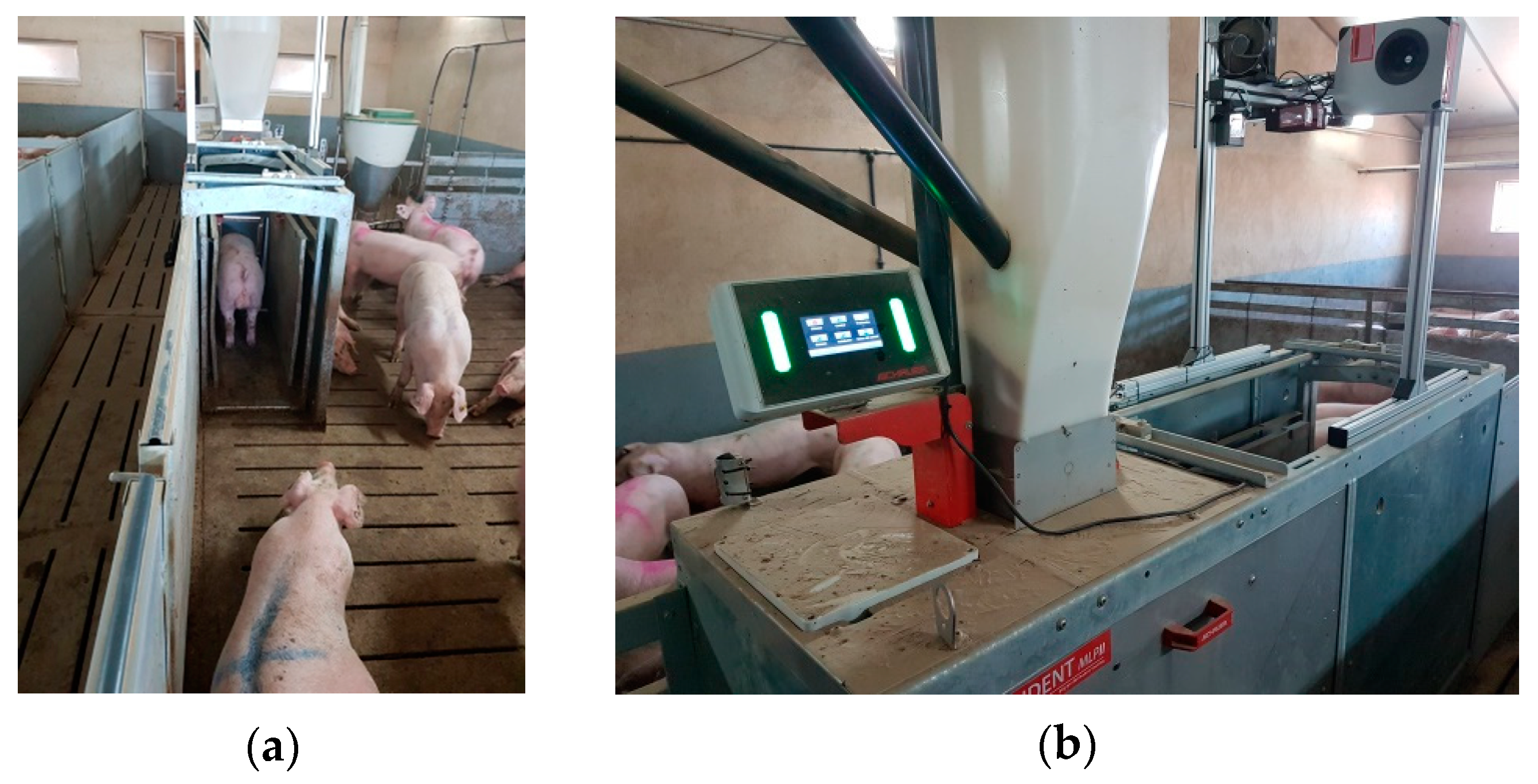
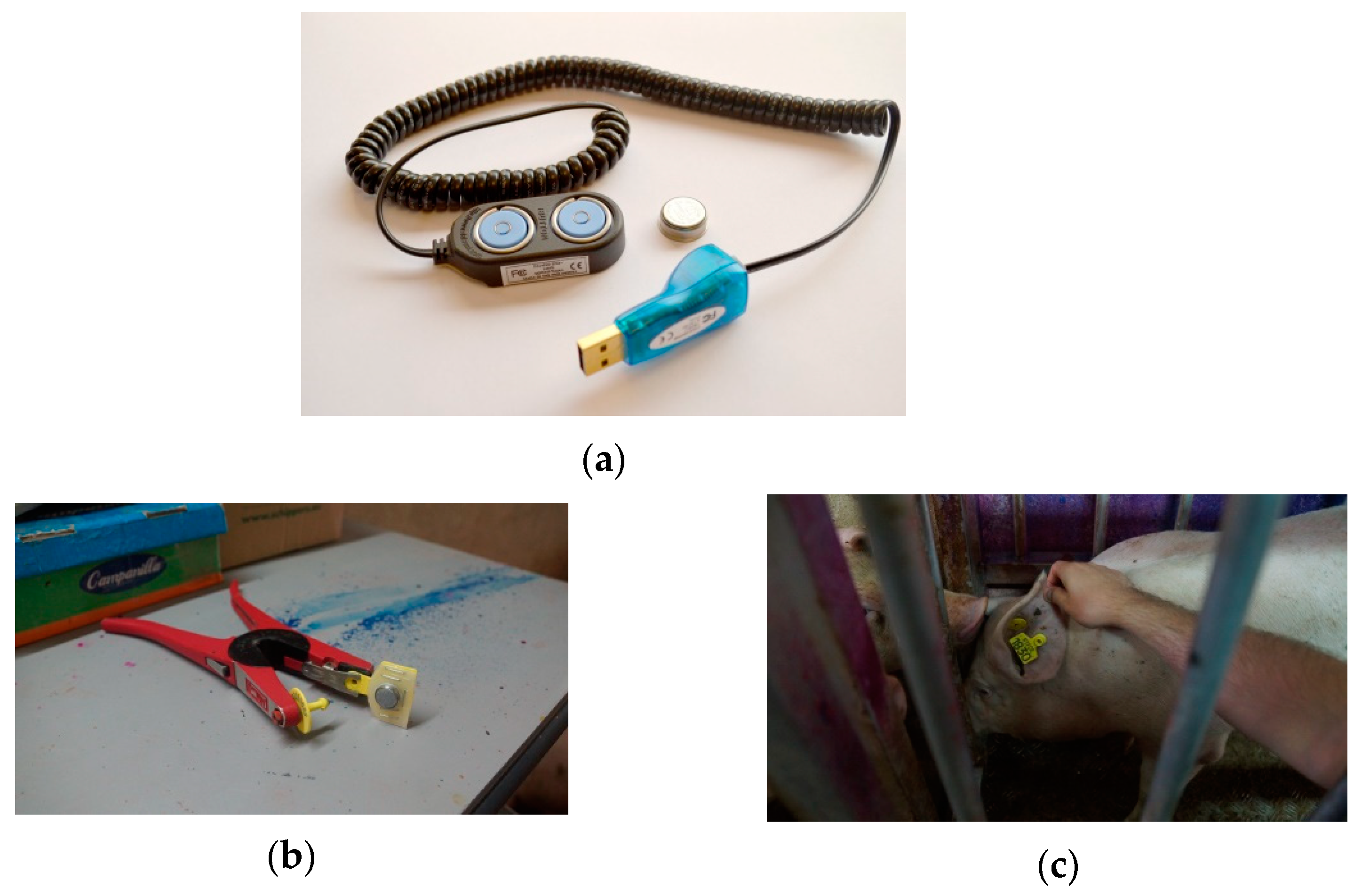
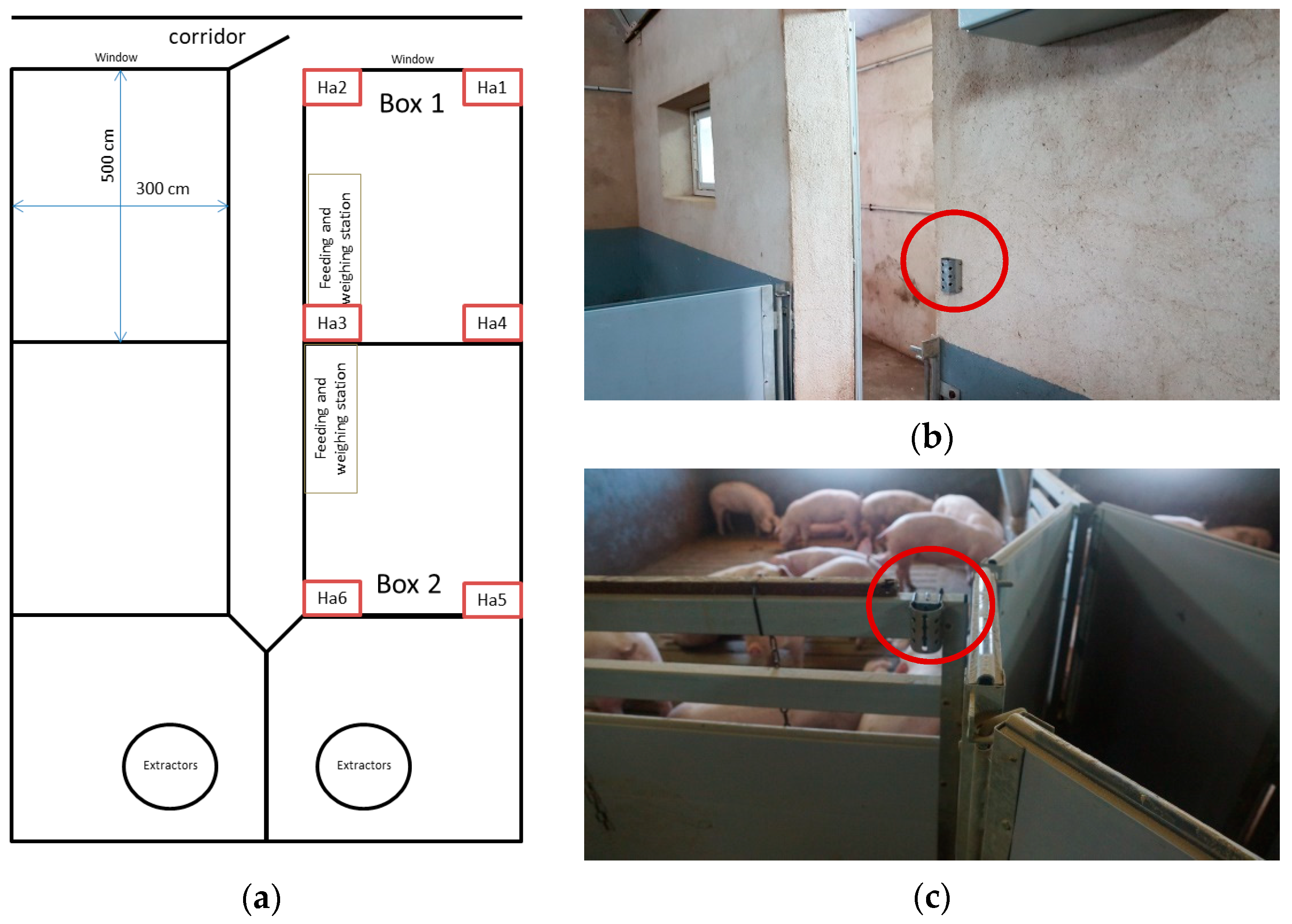
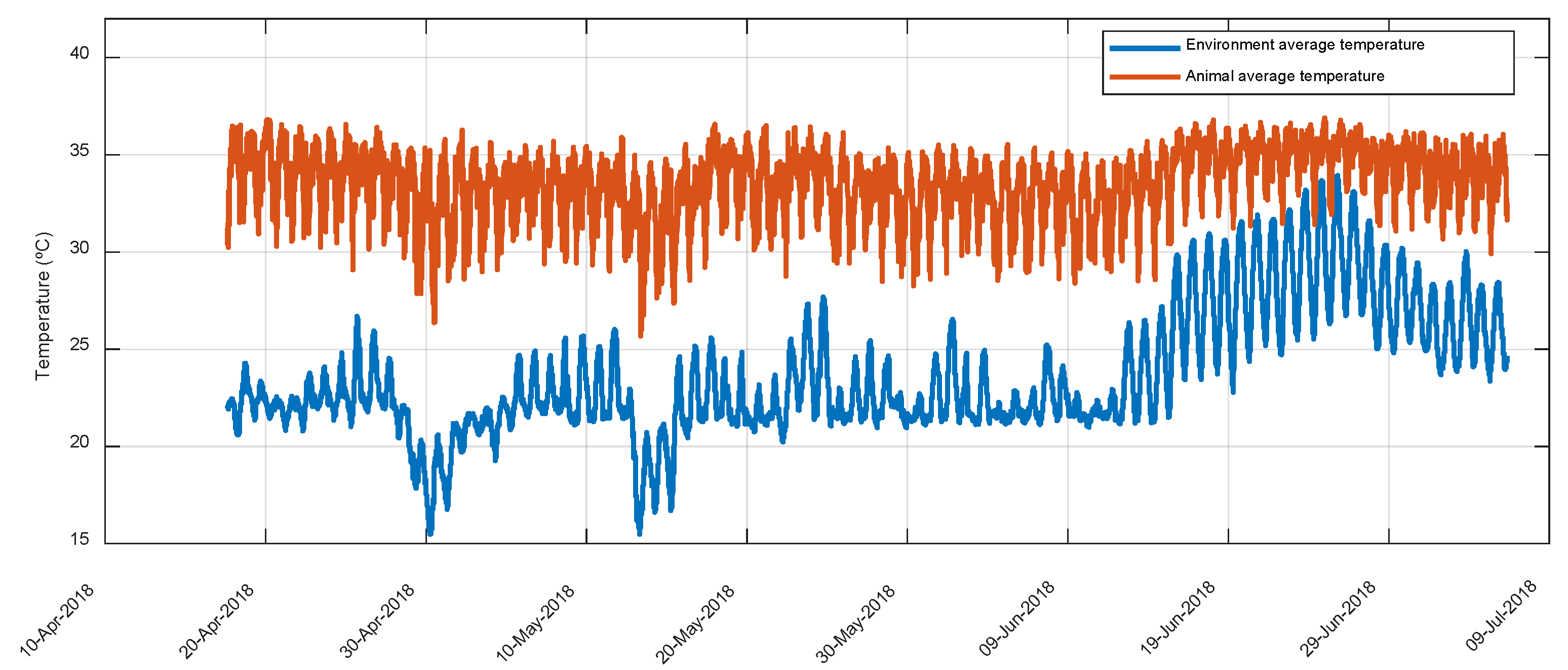

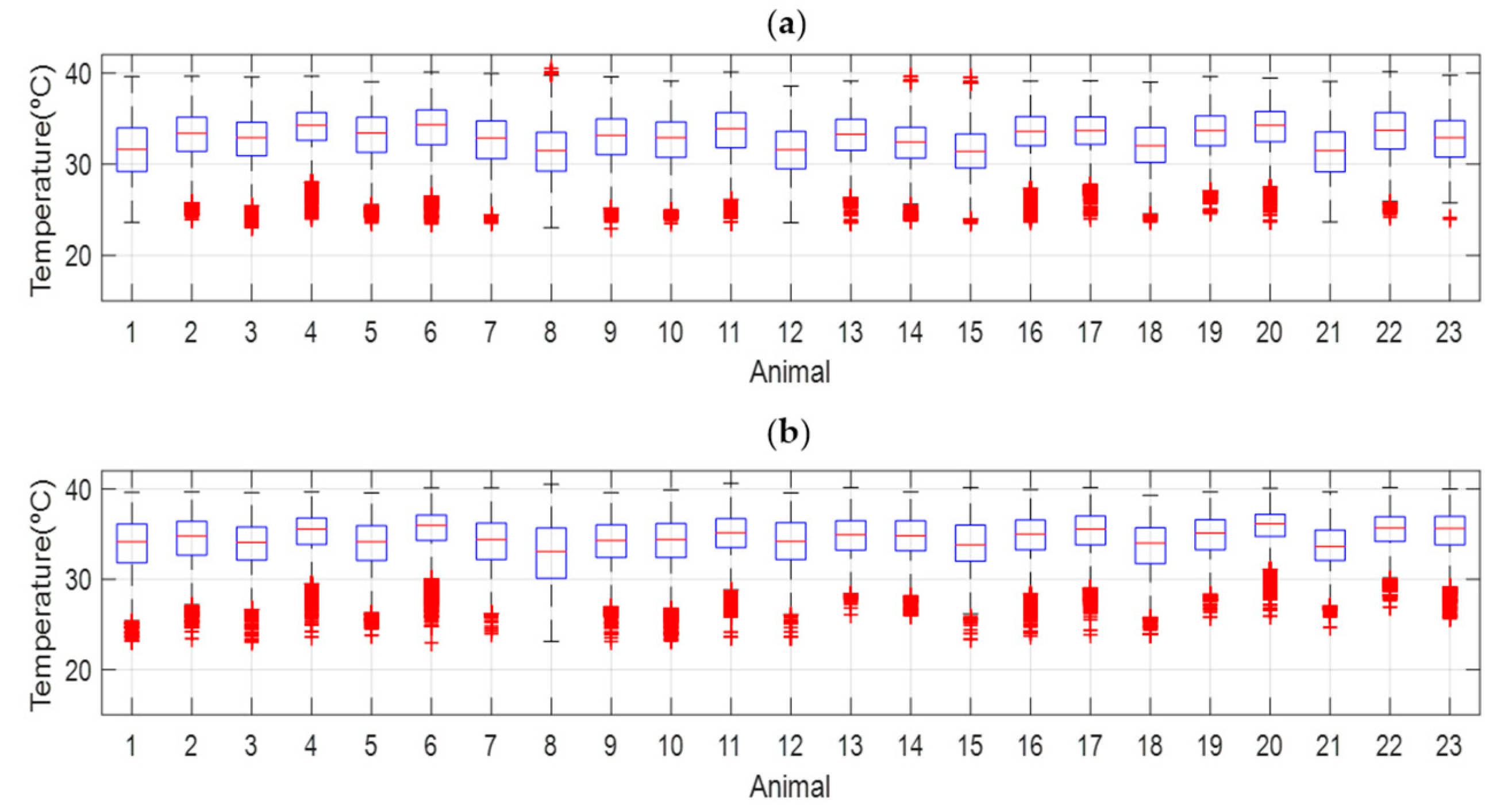
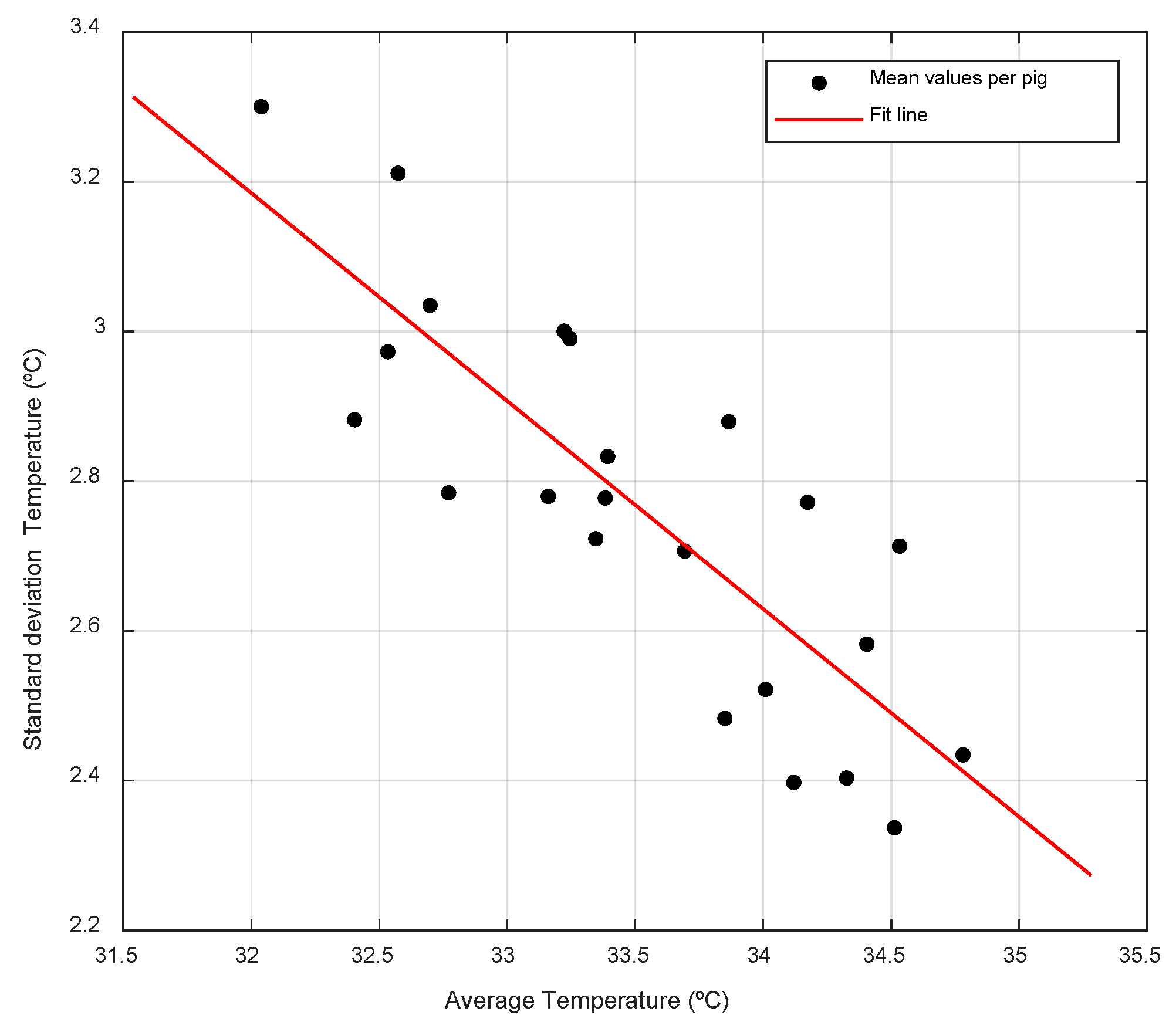
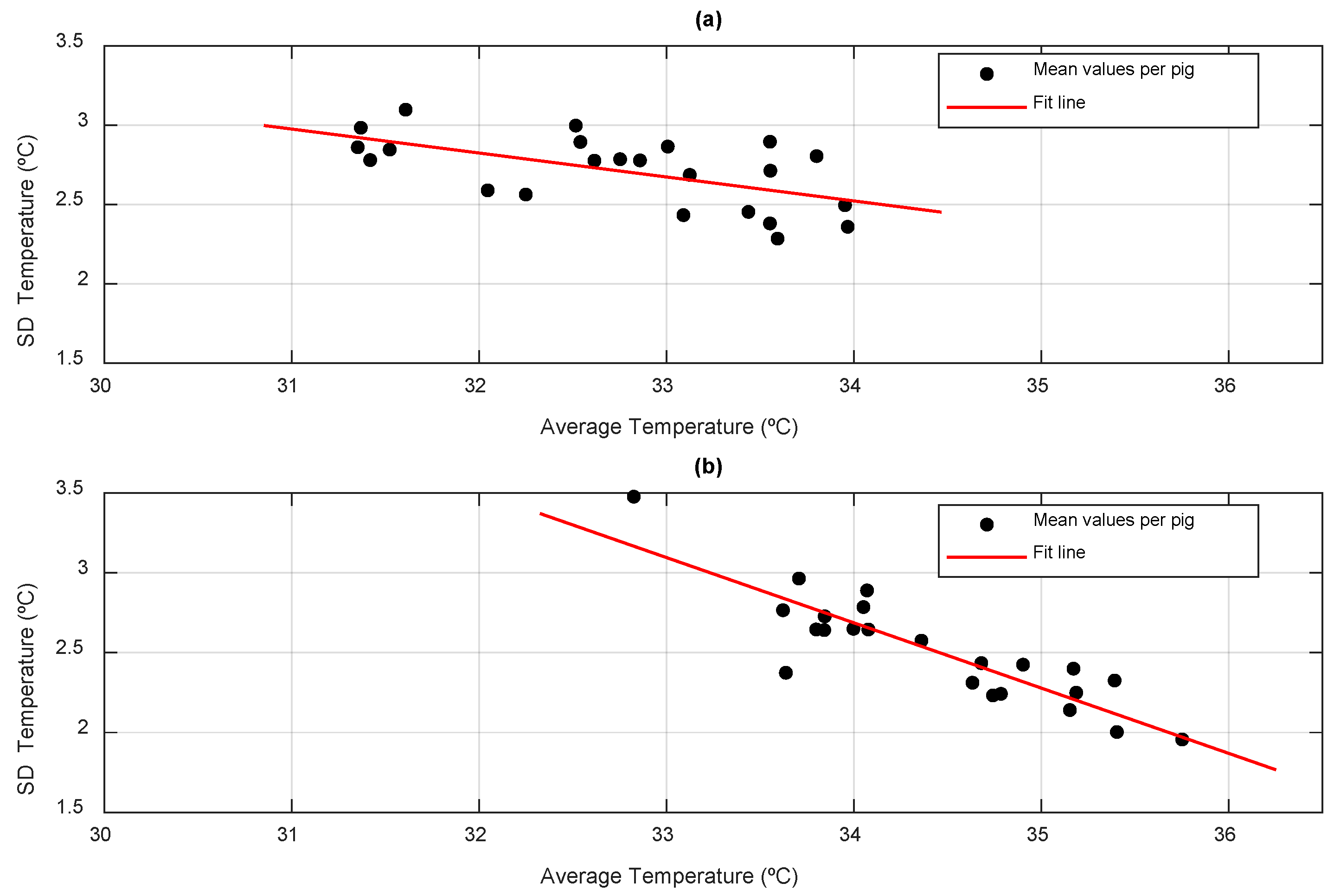
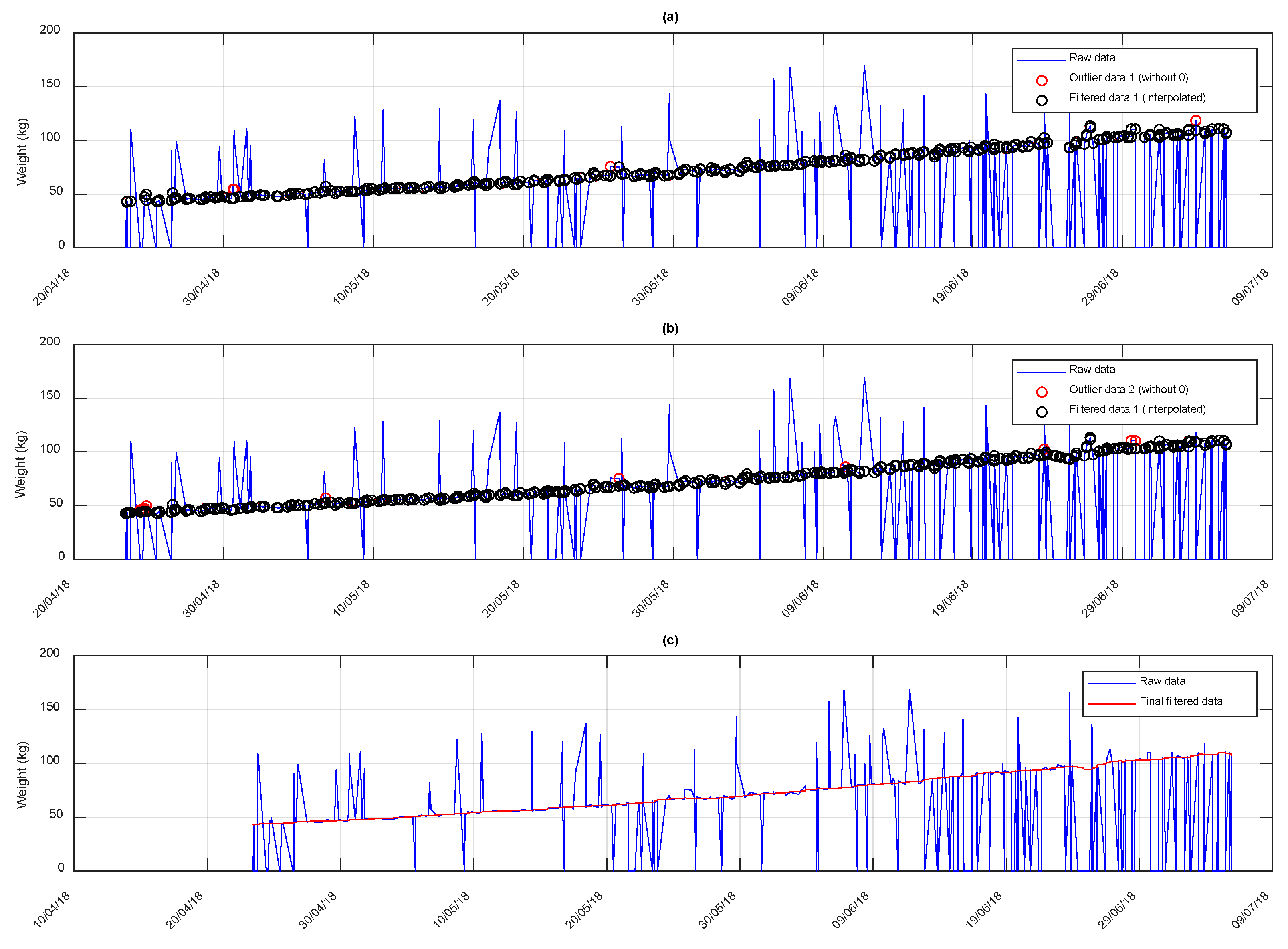

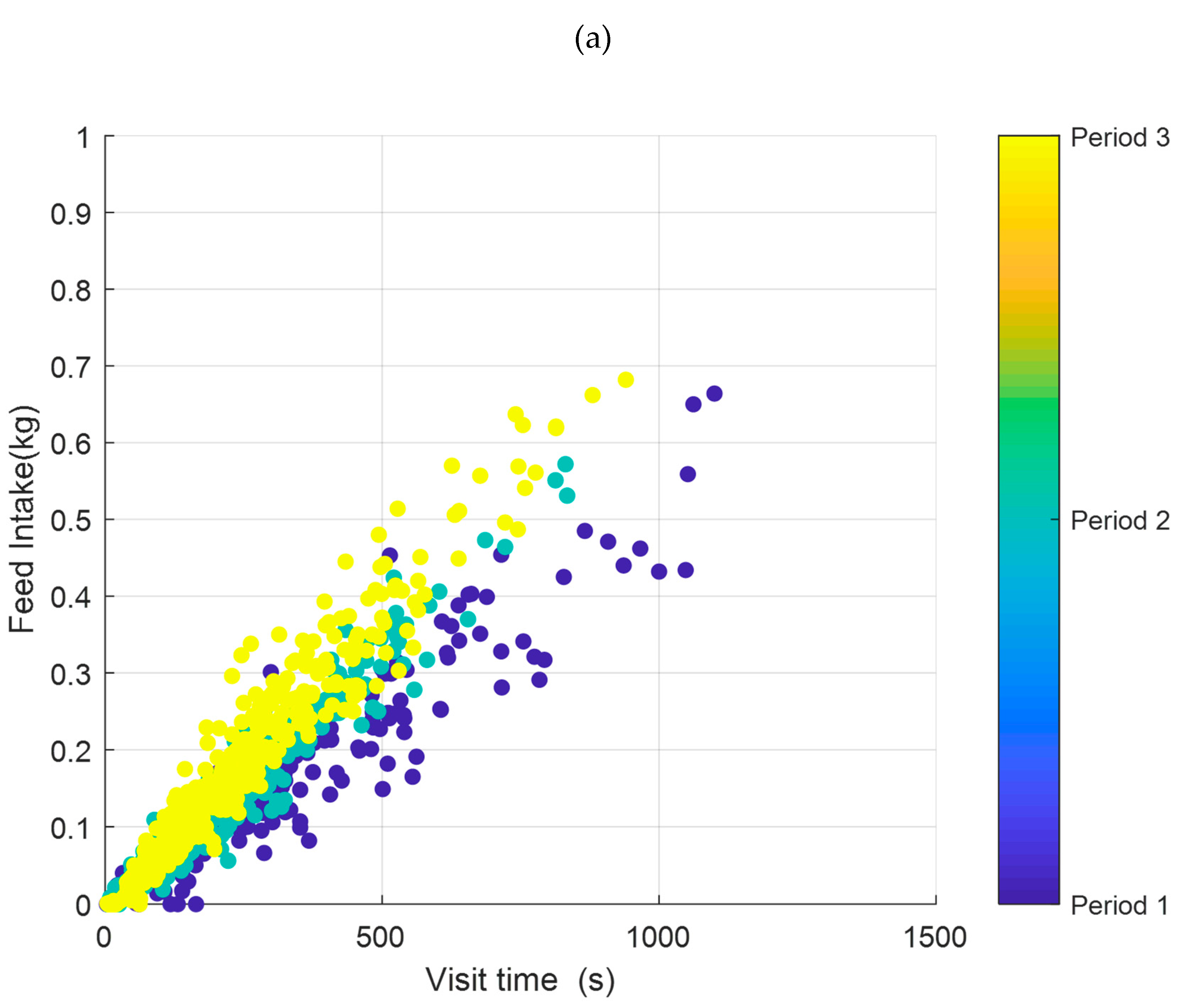
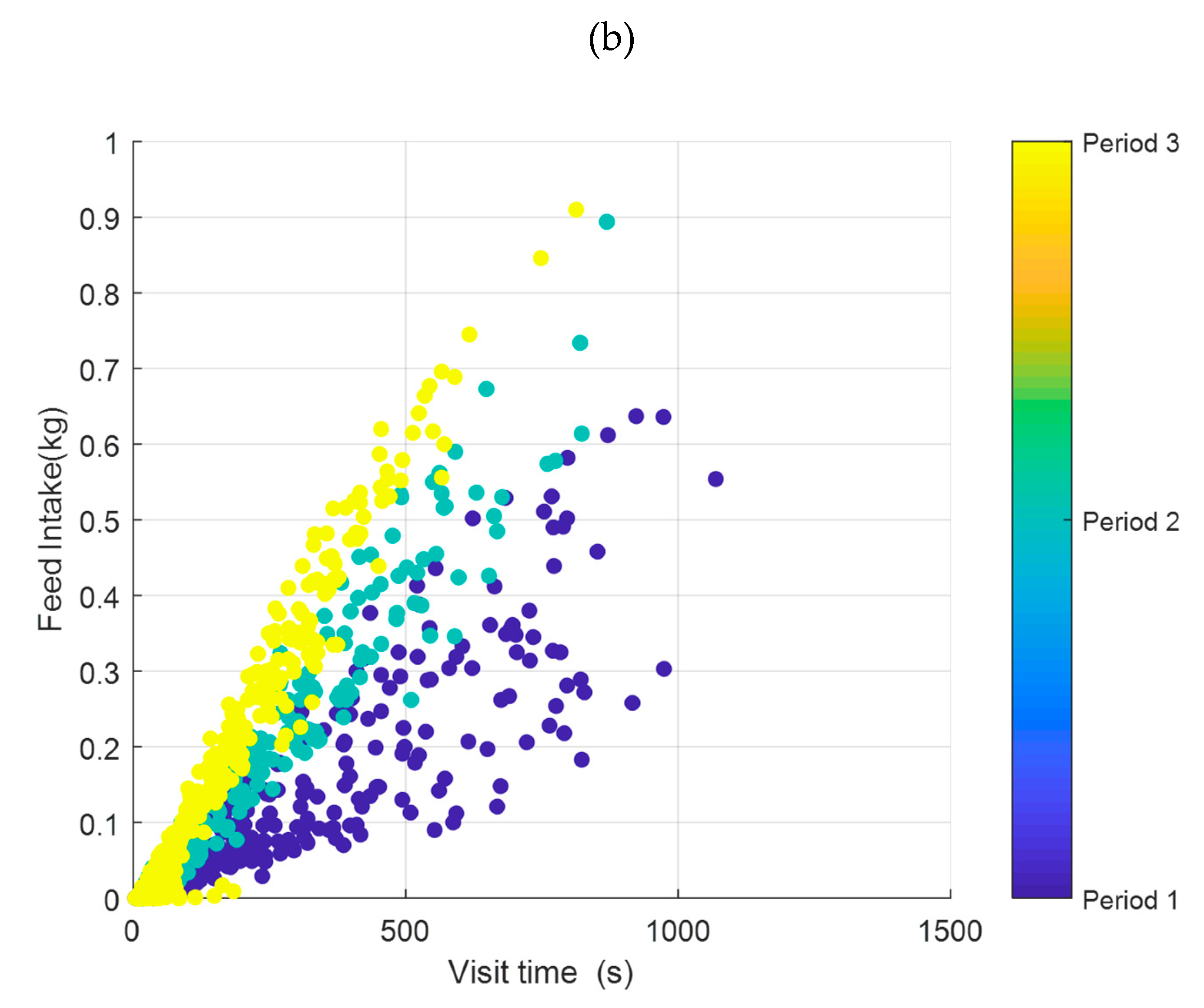
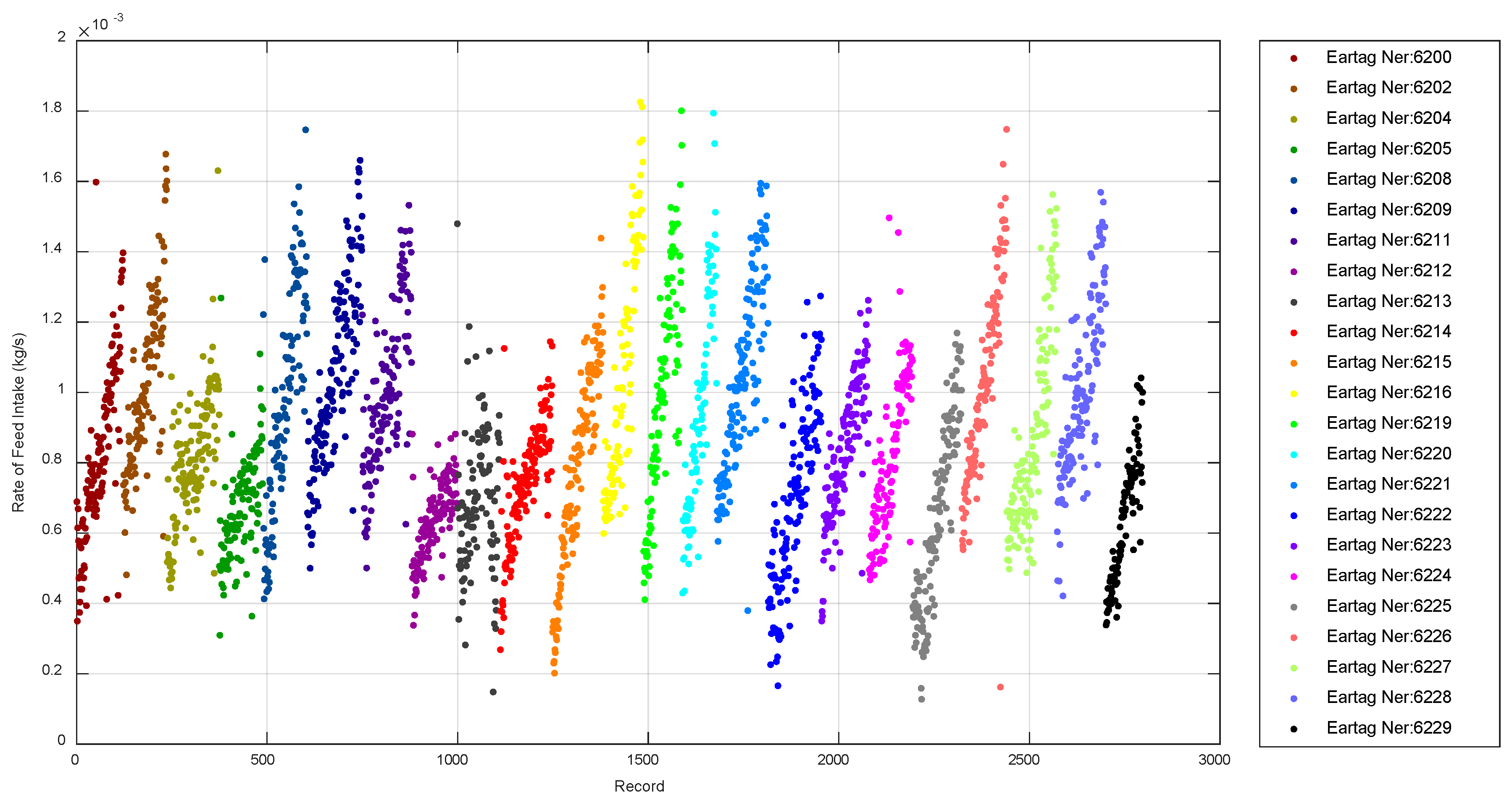
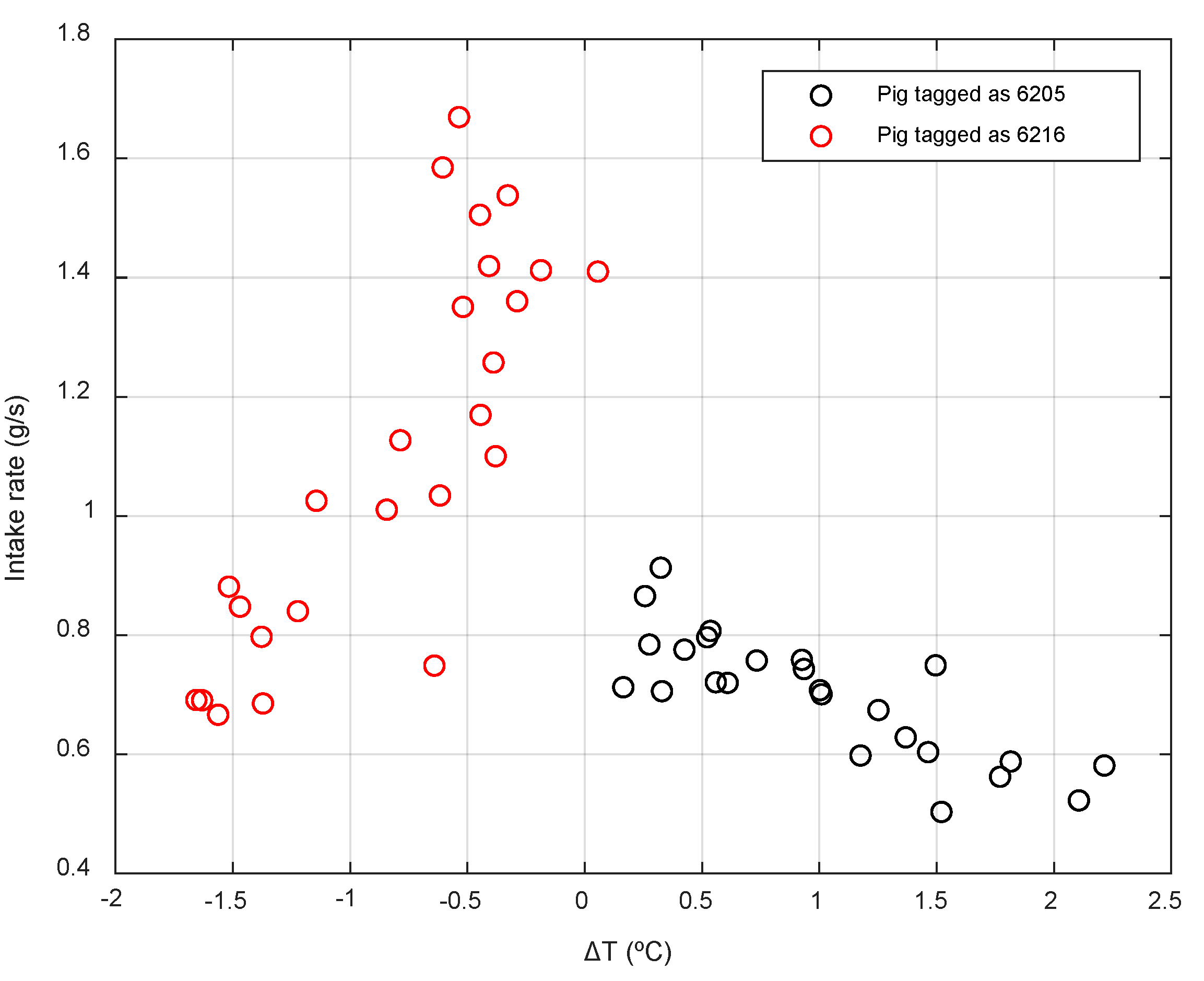
| Pig No. | Eartag No. | Initial Weight (kg) | Final Weight (kg) |
|---|---|---|---|
| 1 | 6200 | 41.4 | 135.0 |
| 2 | 6202 | 41.8 | 130.8 |
| 3 | 6204 | 41.3 | 134.2 |
| 4 | 6205 | 43.8 | 145.6 |
| 5 | 6208 | 43.0 | 132.2 |
| 6 | 6209 | 49.5 | 165.6 |
| 7 | 6211 | 43.0 | 127.9 |
| 8 | 6212 | 40.0 | 116.3 |
| 9 | 6213 | 47.3 | 138.6 |
| 10 | 6214 | 47.7 | 141.9 |
| 11 | 6215 | 40.6 | 101.7 |
| 12 | 6216 | 43.6 | 119.6 |
| 13 | 6219 | 35.6 | 113.3 |
| 14 | 6220 | 44.0 | 131.1 |
| 15 | 6221 | 37.2 | 111.2 |
| 16 | 6222 | 37.7 | 131.2 |
| 17 | 6223 | 37.0 | 119.9 |
| 18 | 6224 | 39.7 | 119.1 |
| 19 | 6225 | 37.7 | 117.1 |
| 20 | 6226 | 45.0 | 147.5 |
| 21 | 6227 | 34.6 | 113.0 |
| 22 | 6228 | 44.5 | 125.7 |
| 23 | 6229 | 39.0 | 107.4 |
| Configuration Features | Animal | Environment |
|---|---|---|
| Number of loggers | 30 | 6 |
| Capacity (data/iButton) | 8192 (8bit) | |
| Resolution (°C/%HR) | 0.5 °C/- | 0.5 °C/0.6% |
| Temperature and Humidity Range | +15 °C to +140 °C- | −20 °C to +85 °C/0 to 100% HR |
| Sampling interval (s/data) | 360 | 720 |
| Number of iButton replacements | 3 | |
| Eartag No. | No. of Visits | Total Visit Time (s) | Average Visit Time (s) | Total Intake (kg) | Average Intake per Visit (kg) | Total Intake Rate (g/s) | Weight Gained (kg) | Efficiency (kg Gained/kg Intake) |
|---|---|---|---|---|---|---|---|---|
| 6200 | 1036 | 237,356 | 229.1 | 199.9 | 0.19 | 0.8423 | 90.5 | 0.45 |
| 6202 | 632 | 174,094 | 275.5 | 181.7 | 0.29 | 1.0436 | 83.1 | 0.46 |
| 6204 | 1088 | 233,361 | 214.5 | 188.1 | 0.17 | 0.8060 | 83.3 | 0.44 |
| 6205 | 1224 | 296,799 | 242.5 | 207.9 | 0.17 | 0.7006 | 97.1 | 0.47 |
| 6208 | 440 | 185,895 | 422.5 | 182.7 | 0.42 | 0.9830 | 85.8 | 0.47 |
| 6209 | 573 | 236,342 | 412.5 | 245.3 | 0.43 | 1.0379 | 110.6 | 0.45 |
| 6211 | 746 | 174,392 | 233.8 | 169.5 | 0.23 | 0.9717 | 79.7 | 0.47 |
| 6212 | 1082 | 260,278 | 240.6 | 166.4 | 0.15 | 0.6393 | 70.8 | 0.43 |
| 6213 | 1777 | 286,004 | 160.9 | 193.7 | 0.11 | 0.6772 | 86.4 | 0.45 |
| 6214 | 676 | 262,681 | 388.6 | 193.1 | 0.29 | 0.7351 | 91.7 | 0.47 |
| 6215 | 915 | 204,616 | 223.6 | 147.4 | 0.16 | 0.7206 | 56.7 | 0.38 |
| 6216 | 726 | 180,982 | 249.3 | 193.4 | 0.27 | 1.0687 | 70.4 | 0.36 |
| 6219 | 1521 | 171,262 | 112.6 | 175.2 | 0.12 | 1.0229 | 69.1 | 0.39 |
| 6220 | 526 | 215,338 | 409.4 | 204.5 | 0.39 | 0.9498 | 79.5 | 0.39 |
| 6221 | 639 | 148,928 | 233.1 | 161.8 | 0.25 | 1.0864 | 69.4 | 0.43 |
| 6222 | 2375 | 298,643 | 125.7 | 193.5 | 0.08 | 0.6481 | 87.3 | 0.45 |
| 6223 | 548 | 226,980 | 414.2 | 193.1 | 0.35 | 0.8508 | 77.3 | 0.40 |
| 6224 | 555 | 200,791 | 361.8 | 165.7 | 0.30 | 0.8252 | 68.7 | 0.41 |
| 6225 | 1099 | 290,816 | 264.6 | 166.5 | 0.15 | 0.5726 | 72.5 | 0.44 |
| 6226 | 2027 | 217,002 | 107.1 | 218.0 | 0.11 | 1.0044 | 95.7 | 0.44 |
| 6227 | 608 | 206,297 | 339.3 | 184.3 | 0.30 | 0.8934 | 69.8 | 0.38 |
| 6228 | 772 | 175,488 | 227.3 | 176.2 | 0.23 | 1.0038 | 74.2 | 0.42 |
| 6229 | 504 | 235,903 | 468.1 | 154.1 | 0.31 | 0.6532 | 64.6 | 0.42 |
| Parameters of the Feeding Station | NV | TVT | AVT | TI | AIV | TIR | WG | E |
|---|---|---|---|---|---|---|---|---|
| Number of visits [NV] | 1.00 | 0.48 | −0.81 | 0.20 | −0.84 | −0.31 | 0.25 | 0.18 |
| Total visit time (s) [TVT] | 0.48 | 1.00 | −0.05 | 0.28 | −0.35 | −0.83 | 0.39 | 0.33 |
| Average visit time (s) [AVT] | −0.81 | −0.05 | 1.00 | 0.03 | 0.90 | 0.00 | 0.00 | −0.04 |
| Total intake (kg) [TI] | 0.20 | 0.28 | 0.03 | 1.00 | 0.21 | 0.27 | 0.88 | 0.25 |
| Average intake per visit (kg) [AIV] | −0.84 | −0.35 | 0.90 | 0.21 | 1.00 | 0.42 | 0.11 | −0.08 |
| Total intake rate (g/s) [TIR] | −0.31 | −0.83 | 0.00 | 0.27 | 0.42 | 1.00 | 0.12 | −0.16 |
| Weight gained (kg) [WG] | 0.25 | 0.39 | 0.00 | 0.88 | 0.11 | 0.12 | 1.00 | 0.67 |
| Efficiency (kg gained/kg intake) [E] | 0.18 | 0.33 | −0.04 | 0.25 | −0.08 | −0.16 | 0.67 | 1.00 |
| Correlations | Acceleration of Rate Feed Intake | Slope of Feed Intake vs. Time (P1) | Slope of Feed Intake vs. Time (P2) | Slope of Feed Intake vs. Time (P3) | Weight Gained | Efficiency |
|---|---|---|---|---|---|---|
| Acceleration of rate feed intake | 1.00 | 0.29 | 0.38 | 0.75 | −0.31 | −0.57 |
| Slope of feed intake vs. time (P1) | 0.29 | 1.00 | 0.86 | 0.72 | 0.11 | −0.14 |
| Slope of feed intake vs. time (P2) | 0.38 | 0.86 | 1.00 | 0.81 | 0.14 | −0.08 |
| Slope of feed intake vs. time (P 3) | 0.75 | 0.72 | 0.81 | 1.00 | −0.07 | −0.30 |
| Weight gained | −0.31 | 0.11 | 0.14 | −0.07 | 1.00 | 0.67 |
| Efficiency | −0.57 | −0.14 | −0.08 | −0.30 | 0.67 | 1.00 |
© 2019 by the authors. Licensee MDPI, Basel, Switzerland. This article is an open access article distributed under the terms and conditions of the Creative Commons Attribution (CC BY) license (http://creativecommons.org/licenses/by/4.0/).
Share and Cite
Garrido-Izard, M.; Correa, E.-C.; Requejo, J.-M.; Diezma, B. Continuous Monitoring of Pigs in Fattening Using a Multi-Sensor System: Behavior Patterns. Animals 2020, 10, 52. https://doi.org/10.3390/ani10010052
Garrido-Izard M, Correa E-C, Requejo J-M, Diezma B. Continuous Monitoring of Pigs in Fattening Using a Multi-Sensor System: Behavior Patterns. Animals. 2020; 10(1):52. https://doi.org/10.3390/ani10010052
Chicago/Turabian StyleGarrido-Izard, Miguel, Eva-Cristina Correa, José-María Requejo, and Belén Diezma. 2020. "Continuous Monitoring of Pigs in Fattening Using a Multi-Sensor System: Behavior Patterns" Animals 10, no. 1: 52. https://doi.org/10.3390/ani10010052
APA StyleGarrido-Izard, M., Correa, E.-C., Requejo, J.-M., & Diezma, B. (2020). Continuous Monitoring of Pigs in Fattening Using a Multi-Sensor System: Behavior Patterns. Animals, 10(1), 52. https://doi.org/10.3390/ani10010052





